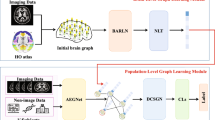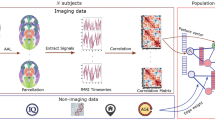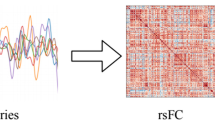Abstract
Purpose
Finding the biomarkers associated with autism spectrum disorder (ASD) is helpful for understanding the underlying roots of the disorder and can lead to earlier diagnosis and more targeted treatments. In essence, we are faced with two challenges (i) how to learn a node representation and a clean graph structure from original graph data with high dimensionality and (ii) how to jointly model the procedure of node representation learning, structure learning and graph classification.
Methods
We propose FSL-BrainNet, an interpretable graph convolution network (GCN) model for jointly Learning of node Features and clean Structures in brain networks for automatic brain network classification and interpretation. We formulate an end-to-end trainable and interpretable framework for graph classification and biomarkers (salient brain regions and potential subnetworks) identification.
Results
The experimental results on the ABIDE dataset show that our proposed methods not only achieve improved prediction performance compared with the state-of-the-art methods, but also find a compact set of highly suggestive biomarkers including relevant brain regions and subnetworks to ASD.
Conclusion
Through node feature learning and structure learning, our model can simultaneously select important brain regions and identify subnetworks.




Similar content being viewed by others
Availability of data and material
Data are publicly available.
References
Li X, Dvornek NC, Zhuang J, Ventola P, Duncan JS (2018) Brain biomarker interpretation in asd using deep learning and fmri. In: international conference on medical image computing and computer-assisted intervention, pp 206–214
Wen G, Cao P, Bao H, Yang W, Zheng T, Zaiane O (2022) Mvs-gcn: a prior brain structure learning-guided multi-view graph convolution network for autism spectrum disorder diagnosis. Comput Biol Med 142:105239
Kazeminejad A, Sotero RC (2019) Topological properties of resting-state fmri functional networks improve machine learning-based autism classification. Front Neurosci 12:1018
Van Den Heuvel MP, Pol HEH (2010) Exploring the brain network: a review on resting-state fmri functional connectivity. Eur Neuropsychopharmacol 20(8):519–534
Welling M, Kipf TN (2017) Semi-supervised classification with graph convolutional networks. In: J. international conference on learning representations: ICLR 2017
Li X, Zhou Y, Dvornek N, Zhang M, Gao S, Zhuang J, Scheinost D, Staib LH, Ventola P, Duncan JS (2021) Braingnn: interpretable brain graph neural network for fmri analysis. Med Image Anal 74:102233
Parisot S, Ktena SI, Ferrante E, Lee M, Moreno RG, Glocker B, Rueckert D (2017) Spectral graph convolutions for population-based disease prediction. In: international conference on medical image computing and computer-assisted intervention, pp 177–185
Yan Y, Zhu J, Duda M, Solarz E, Sripada C, Koutra D (2019) Groupinn: Grouping-based interpretable neural network for classification of limited, noisy brain data. In: proceedings of the 25th ACM SIGKDD international conference on knowledge discovery & data mining, pp 772–782
Jiang H, Cao P, Xu M, Yang J, Zaiane O (2020) Hi-gcn: a hierarchical graph convolution network for graph embedding learning of brain network and brain disorders prediction. Comput Biol Med 127:104096
Chen Y, Liu A, Fu X, Wen J, Chen X. An iInvertible dynamic graph convolutional network for multi-center ASD classification. Front Neurosci 15:828512
Gürbüz MB, Rekik I (2021) Mgn-net: a multi-view graph normalizer for integrating heterogeneous biological network populations. Med Image Anal 71:102059
Wang Y, Liu J, Xiang Y, Wang J, Chen Q, Chong J (2022) Mage: automatic diagnosis of autism spectrum disorders using multi-atlas graph convolutional networks and ensemble learning. Neurocomputing 469:346–353
Cao M, Yang M, Qin C, Zhu X, Chen Y, Wang J, Liu T (2021) Using deepgcn to identify the autism spectrum disorder from multi-site resting-state data. Biomed Signal Process Control 70:103015
Banka A, Buzi I, Rekik I (2020) Multi-view brain hyperconnectome autoencoder for brain state classification. In: international workshop on predictive intelligence in medicine pp 101–110
Cao P, Wen G, Yang W, Liu X, Yang J, Zaiane O (2022) A unified framework of graph structure learning, graph generation and classification for brain network analysis. Appl Intell 1–14
Dauphin YN, Fan A, Auli M, Grangier D (2017) Language modeling with gated convolutional networks. In: international conference on machine learning pp 933–941
Abel R, Benami I, Louzoun Y (2020) Topological based classification using graph convolutional networks. international conference on learning representations: ICLR 2020
Ma X, Qin G, Qiu Z, Zheng M, Wang Z (2019) Riwalk: Fast structural node embedding via role identification. In: 2019 IEEE international conference on data mining (ICDM) pp 478–487
Li Q, Wu X-M, Liu H, Zhang X, Guan Z (2019) Label efficient semi-supervised learning via graph filtering. In: proceedings of the IEEE/CVF conference on computer vision and pattern recognition pp 9582–9591
Li G, Muller M, Thabet A, Ghanem B (2019) Deepgcns: Can gcns go as deep as cnns? In: proceedings of the IEEE/CVF international conference on computer vision pp 9267–9276
Di Martino A, Yan C-G, Li Q, Denio E, Castellanos FX, Alaerts K, Anderson JS, Assaf M, Bookheimer SY, Dapretto M et al (2014) The autism brain imaging data exchange: towards a large-scale evaluation of the intrinsic brain architecture in autism. Mol Psychiatry 19(6):659–667
Craddock C, Benhajali Y, Chu C, Chouinard F, Evans A, Jakab A, Khundrakpam BS, Lewis JD, Li Q, Milham M, Yan C, Bellec P (2013) The neuro bureau preprocessing initiative: open sharing of preprocessed neuroimaging data and derivatives. Front Neuroinform 7:27
Yan C-G, Wang X-D, Zuo X-N, Zang Y-F (2016) Dpabi: data processing & analysis for (resting-state) brain imaging. Neuroinformatics 14(3):339–351
Ma Y, Wang S, Aggarwal CC, Tang J (2019) Graph convolutional networks with eigenpooling. In: proceedings of the 25th ACM sigkdd international conference on knowledge discovery & data mining pp 723–731
Eslami T, Mirjalili V, Fong A, Laird AR, Saeed F (2019) Asd-diagnet: a hybrid learning approach for detection of autism spectrum disorder using fmri data. Front Neuroinform 13:70
Wee C-Y, Yap P-T, Zhang D, Denny K, Browndyke JN, Potter GG, Welsh-Bohmer KA, Wang L, Shen D (2012) Identification of mci individuals using structural and functional connectivity networks. Neuroimage 59(3):2045–2056
Cao B, He L, Wei X, Xing M, Yu PS, Klumpp H, Leow AD (2017) t-bne: Tensor-based brain network embedding. In: proceedings of the 2017 SIAM international conference on data mining pp 189–197
Kudo T, Maeda E, Matsumoto Y (2004) An application of boosting to graph classification. In: advances in neural information processing systems pp 729–736
Zhang D, Huang J, Jie B, Du J, Tu L, Liu M (2018) Ordinal pattern: a new descriptor for brain connectivity networks. IEEE Trans Med Imaging 37(7):1711–1722
Yang T, Frangou S, Lam RW, Huang J, Su Y, Zhao G, Mao R, Zhu N, Zhou R, Lin X et al (2021) Probing the clinical and brain structural boundaries of bipolar and major depressive disorder. Transl Psychiatry 11(1):1–8
Funding
This research was supported by the National Natural Science Foundation of China (No.62076059) and the Science Project of Liaoning province (2021-MS-105).
Author information
Authors and Affiliations
Corresponding author
Ethics declarations
Conflict of interest
The authors declare that they have no conflict of interest.
Ethics approval
This article does not contain any studies with human participants or animals performed by any of the authors.
Informed consent
Not applicable.
Additional information
Publisher's Note
Springer Nature remains neutral with regard to jurisdictional claims in published maps and institutional affiliations.
Rights and permissions
Springer Nature or its licensor (e.g. a society or other partner) holds exclusive rights to this article under a publishing agreement with the author(s) or other rightsholder(s); author self-archiving of the accepted manuscript version of this article is solely governed by the terms of such publishing agreement and applicable law.
About this article
Cite this article
Li, L., Wen, G., Cao, P. et al. Exploring interpretable graph convolutional networks for autism spectrum disorder diagnosis. Int J CARS 18, 663–673 (2023). https://doi.org/10.1007/s11548-022-02780-3
Received:
Accepted:
Published:
Issue Date:
DOI: https://doi.org/10.1007/s11548-022-02780-3




